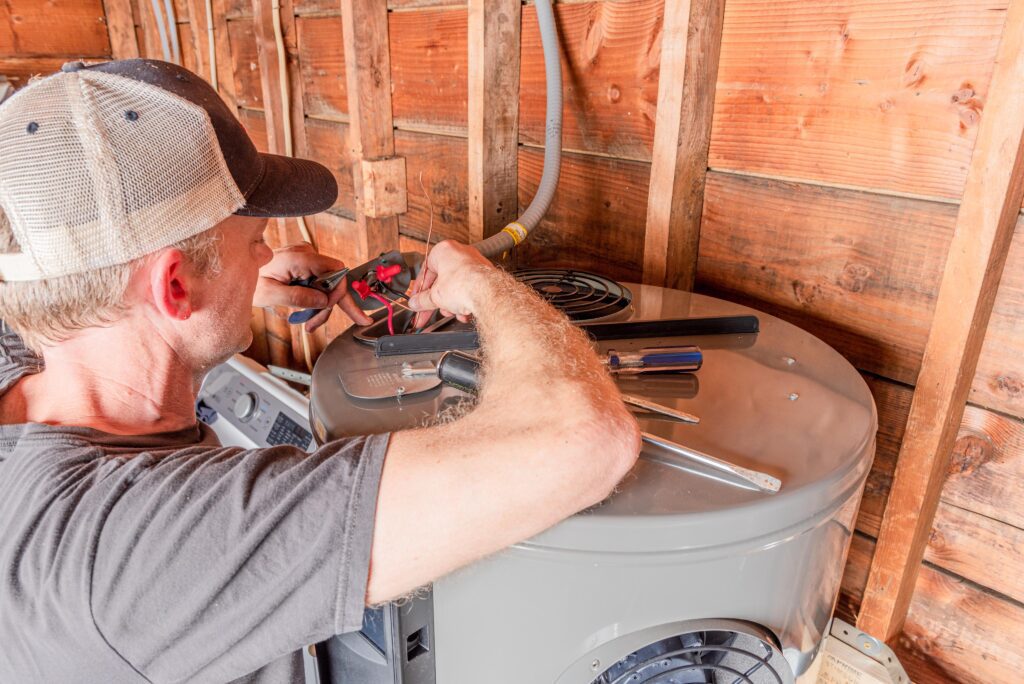Discover five actions that can accelerate New York’s transition to efficient, electric hot water.

Major policies at the local, state and federal levels are setting the stage for a water heater market transformation in New York, and new policy ideas could push farther and faster in the years ahead. But the push to scale heat pump water heaters (HPWHs) must navigate affordability challenges, close technology gaps and support workforce transition.
Decarbonization laws, efficiency standards, and voluntary incentives are sending strong signals to manufacturers, distributors and contractors on the future growth of the heat pump water heater market. These policies show that New York State is already invested in transitioning to efficient, electric hot water. But the current level of incentives is not sufficient to ensure that most homeowners can affordably make this transition, and without continued action, the momentum built over the last few years could stall.
Local Law 154 (LL154): Began requiring all-electric new construction, including no fossil-fuel water heating in one- to two-family homes, starting in 2024, and all buildings starting in July 2027. Our estimates show 2,000-3,000 new buildings are constructed each year in NYC, most of which are one- to two-family homes.
Local Law 97 (LL97): Sets annual carbon caps on large buildings from 2024 onward. Over time, LL97 will encourage the electrification of hot water in the 18,000 existing multifamily buildings covered by the law to meet the limits, and a beneficial electrification credit adds extra incentive for buildings that do so before 2030.
All-Electric New Buildings Act & the 2025 NYS Energy Conservation Construction Code:
Together, these laws make New York the first state to require all-electric new construction. Starting in 2026, the State Energy Code will prohibit fossil-fuel water heating equipment in residential buildings up to seven stories, heavily favoring HPWH as the system of choice. To quantify how many new HPWHs that may mean annually, roughly 10,000 new single family homes were built in NY in 2024, and around 1,000 multifamily buildings with 35,000 units are built each year.
Climate Leadership and Community Protection Act (CLCPA): The law sets ambitious economy-wide targets to drive down carbon emissions statewide. The CLCPA Scoping Plan, while not binding, recommends phasing out fossil fuel domestic hot water replacements in existing buildings starting in 2030.
Multistate MOU to Accelerate Zero-Emissions Buildings: In 2024 New York signed onto a multistate memorandum of understanding (MOU) to accelerate the transition to zero-emissions residential buildings. By signing, New York pledged to target heat pumps to make up 65% of residential-scale heating, air conditioning, and hot water equipment sales by 2030, and 90% by 2040. Along with nine other states and Washington DC, the signatories represent one-third of residential fossil fuel consumption in the US.
Federal Energy Conservation Standards for Consumer Water Heaters: A 2024 Department of Energy Rule set new efficiency standards for electric- and gas-powered water heaters, effectively shifting the electric tank water heater market to heat pumps, rather than electric resistance. There are over 700,000 single-family homes that use electricity for water heating in New York State. In most cases, when those units need replacing, efficient HPWH will take their place.
From Potential to Practice
Many of New York’s single-family homes are primed for heat pump water heaters, but major challenges lie on the path to transforming the statewide market. The following five actions could address key barriers and help accelerate adoption:
1) Target the right homes first
Issue: For more than 650,000 New York homes, heat pump water heaters are a straightforward conversion that will save money on utility bills right away, reduce GHG emissions and improve local air quality. Yet, outreach and incentive programs often don’t adequately target these priority homes.
Recommendation: Ensure programs and policies target these best-fit homes. Some already do so: for example, federal electric water heater standards only apply to homes with costly electric water heaters. But segmenting incentives by fuel type, space readiness or climate zone (with marketing tailored accordingly) could drive more strategic HPWH deployment. Continued support for low- and moderate-income households remains essential.
2) Maintain and expand affordability
Issue: Heat pump water heaters remain more expensive than conventional water heaters, and the federal pullback on incentives could push costs higher and undermine the momentum of the past few years, sacrificing both HPWH installs and clean energy jobs.
Recommendation: Maintain current levels of funding for HPWH incentives and contractor training, including plugging any gaps from diminishing federal support. The New York Cap-and-Invest program is a potentially transformative funding source to support HPWHs, but new and creative programs like a “cash-for-clunkers” rebate for old fossil-fuel water heaters would help expand affordability.
Figure 6
3) Minimize risk for contractors and installers
Issue: Manufacturer guidance can be uneven, and some contractors and installers are hesitant to offer HPWH because of limited familiarity with the technology. Installations that don’t meet the necessary specifications can lead to a higher failure rate and costly callbacks. Contractors typically bear that financial risk because most warranties don’t cover labor costs to replace or repair a unit, even when the failure is due to a manufacturing error.
Recommendations:
- Increase guidance and installer training to optimize installations and minimize unit failures. This includes micro-learning modules, “no-go” field checklists on height, air flow, and spacing, and laminated homeowner guidance for operation.
- Build contractor confidence and mitigate the perceived burden of unit failure by making manufacturer-backed labor warranties a condition of program eligibility or creating a statewide failure relief fund for early failures.
4) Foster innovation to close tech gaps
Issue: Some homes—such as those without basements or available semi-conditioned space — are simply not good candidates for current HPWHs because of equipment size or other considerations. And some homes with very high hot water demand may benefit from a system with higher capacity.
Recommendation: Incentivize innovation for HPWH designs with different configurations and space requirements, emphasizing solutions for homes without basements. Examples include heat pump water heaters with different-shaped storage tanks for lower spaces and new split HPWH systems, which typically have higher capacities and are suitable for the single-family home market.
5) Fill in missing property data on Long Island
Issue: Thousands of homes on Long Island are likely a strong fit for HPWH installations, but these census tracts are not classified as target areas in our research because they lack key building characteristics data. We suspect these homes are great candidates for HPWHs due to the prevalence of fuel oil, geographic location in Climate Zone 4 and reports from contractors on high numbers of HPWH installations in the area. As a result, our research is likely missing a crucial potential success story for this region of the state.
Recommendation: The NYS Department of Taxation and Finance should review the data collection and upload process for information collected by assessors on property assessment report cards to flag and fix missing data. The Office of Real Property Tax Services should seek to fill in any gaps for census tracts that omit key building characteristics, starting with those on Long Island, so that market actors and incentive programs can better target homes most primed for HPWH retrofits.

